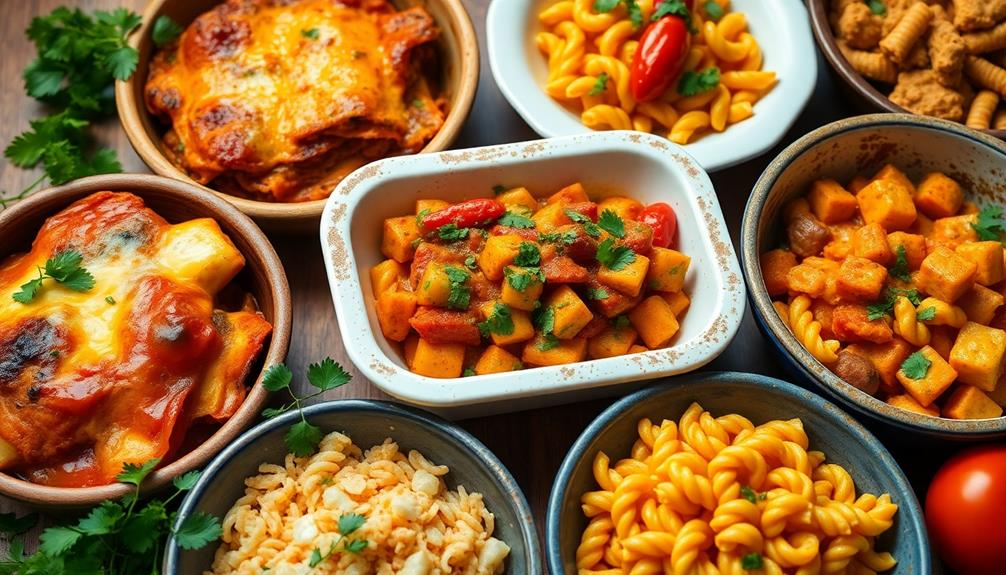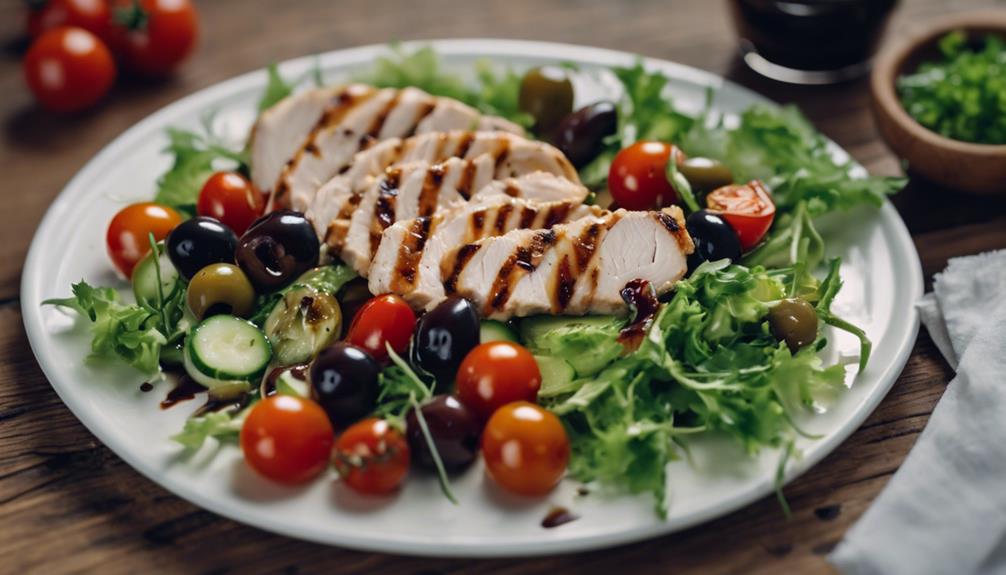Some foods taste better as leftovers because of the chemical reactions that happen during storage. As flavors meld together, dishes like stews, curries, and soups achieve a richer taste. The Maillard reaction continues to work, enhancing savory notes, while starches break down into simpler sugars, making everything sweeter. Reheating these meals opens up even more flavor potential, bringing out umami notes from proteins. Plus, the texture often becomes creamier, offering a delightful mouthfeel. If you're curious about which foods improve the most or how to store them, there's plenty more to discover.
Key Takeaways
- Aging enhances flavors and textures in foods through chemical reactions, making dishes like stews and curries taste better over time.
- The Maillard reaction and protein breakdown increase umami flavors, enriching the overall taste experience in leftovers.
- Starch retrogradation in leftover foods enhances sweetness and texture, leading to a more enjoyable mouthfeel.
- Reheating leftovers allows flavors to meld, intensifying taste and improving moisture retention in dishes like soups and casseroles.
- Proper storage and reheating techniques maintain flavor integrity, ensuring that leftovers can taste even better than freshly prepared meals.
The Science of Aging Foods
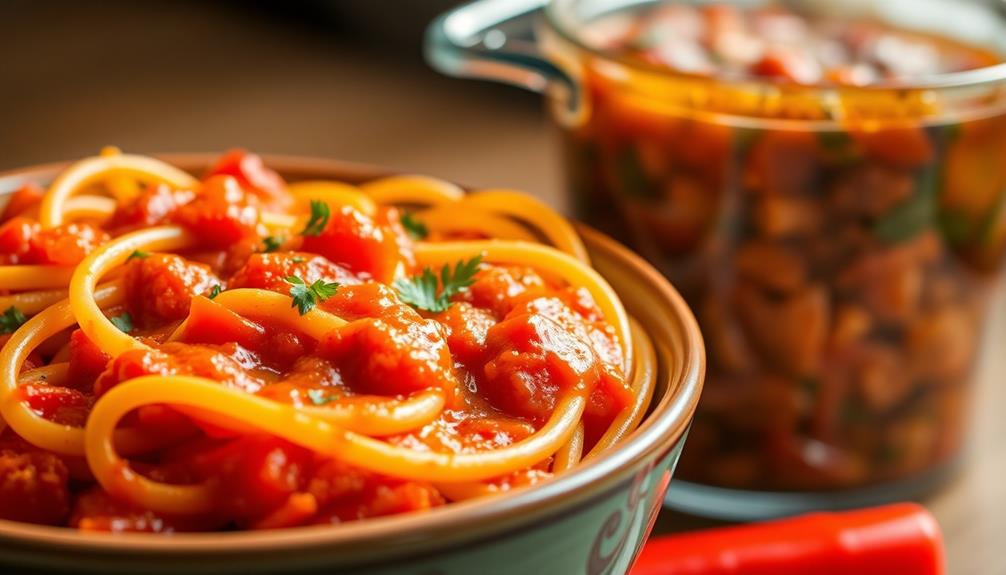
Aging foods isn't just a matter of time; it's a fascinating process that enhances flavors and textures. As foods rest, chemical reactions take center stage. One significant reaction is the Maillard reaction, which occurs during cooking and continues to develop flavor molecules even after storage. This ongoing transformation enriches the taste of your leftovers, making them more enjoyable.
For instance, dishes like Turkey Soup benefit greatly from this process, as the flavors meld together beautifully over time.
Starch retrogradation plays an essential role as well. When gelatinized starches cool, they crystallize, altering the texture of your dishes. This process can enhance the mouthfeel, making reheated meals like risottos or casseroles even more appealing.
You might notice that flavors mellow and blend beautifully as the ingredients harmonize over time, especially in complex dishes like stews and curries.
Refrigeration slows down spoilage but doesn't halt flavor development. In fact, it allows umami-rich compounds in protein-heavy dishes to intensify, adding depth to your leftovers.
Flavor Development Through Chemical Reactions
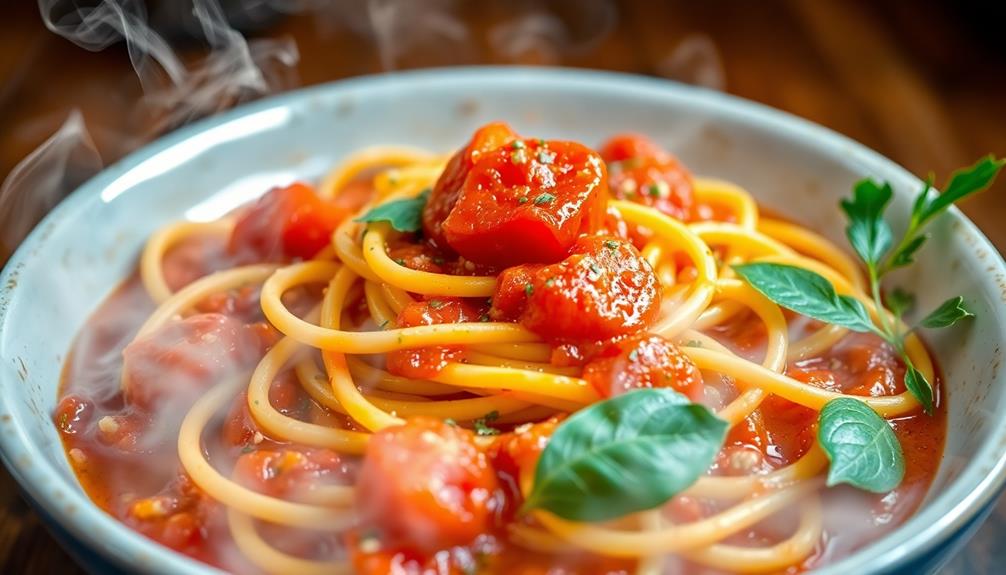
As you let your leftovers sit, chemical reactions are at work, enhancing their flavor and texture.
Dishes like Mushroom Masala and curries often benefit from this aging process, as the rich blend of spices continues to develop and meld together.
Aging foods not only mellows harsh flavors but also builds a more complex taste profile, making each bite more satisfying.
You might find that dishes like soups and curries become surprisingly harmonious after a day in the fridge.
Chemical Reactions Enhance Flavor
Chemical reactions play a crucial role in enhancing the flavors of leftover foods, transforming them into something even more delicious. As leftovers sit, these reactions continue to evolve, deepening the complexity of flavors you experience. For instance, during cooking, the Maillard reaction creates rich flavors, and this process carries on as the food rests.
| Chemical Reaction | Flavor Enhancement |
|---|---|
| Maillard Reaction | Intensifies savory, roasted flavors |
| Starch Retrogradation | Releases sugars, heightens sweetness |
| Protein Breakdown | Frees amino acids, boosts umami taste |
| Flavor Meld in Soups/Curries | Balances and harmonizes diverse flavors |
| Reheating | Liberates trapped flavors for richer taste |
In leftover dishes like stews or mashed potatoes, the retrogradation of starches can create a delightful texture while increasing perceived sweetness. Meanwhile, proteins break down during storage, enhancing umami in meats and sauces. Finally, reheating allows flavors to integrate further, ensuring your leftovers are not just meals but a flavorful experience worth savoring.
Aging Improves Taste Complexity
Leftover dishes often surprise you with their depth of flavor, thanks to the natural aging process that enhances taste complexity. As foods age, chemical reactions occur that break down proteins into amino acids, intensifying umami flavors. This is particularly noticeable in dishes like Red-Braised Pork Belly, where the slow braising method allows for a rich flavor profile to develop over time.
The Maillard reaction, which you may notice during the browning of meats, plays a significant role in developing rich and complex profiles in your leftover dishes.
Starchy vegetables like potatoes also transform as they age; their starches convert into simpler sugars, making them taste sweeter and altering their overall flavor dynamics. Dishes like soups and curries benefit greatly from this aging process as well. While they sit in the fridge, the flavors meld and deepen, resulting in a more balanced and harmonious taste when you reheat them.
Reheating leftovers can further enhance this flavor integration, allowing for a greater release of flavor molecules that developed during aging.
Foods That Improve With Time
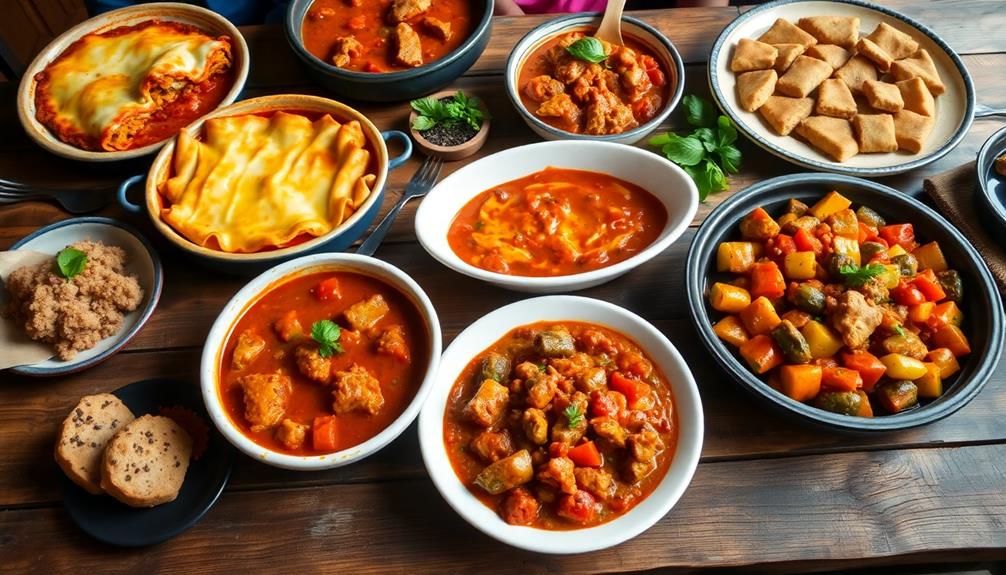
When you let certain dishes sit, you'll notice the flavors meld beautifully over time.
Traditional Brazilian dishes like Caldeirada and Caruru showcase how stewing allows spices to deepen and enhance the overall taste.
Proteins like meats also gain an enhanced umami punch as they rest, making them more satisfying.
Plus, casseroles retain moisture, which helps develop a creamy texture that's hard to resist when reheated.
Flavor Melding Over Time
Some dishes just get better with time, transforming into something truly delicious after a day in the fridge. You might find that soups, stews, and casseroles improve greatly as the flavors meld and balance out. The harmony of ingredients creates a taste profile that's simply better than when it was freshly made.
Spicy curries, for instance, deepen and intensify in flavor, thanks to the spices having more time to infuse throughout the dish. Even traditional Japanese dishes like dorayaki can develop richer tastes when allowed to sit, as the sweetness of the red bean paste can permeate the pancakes more thoroughly.
Even starchy foods like mashed potatoes and lentils can surprise you with a sweeter taste after some time. This happens because the breakdown of starches into simpler sugars enhances their natural sweetness.
And let's not forget about the Maillard reaction; the browning that occurs during cooking continues to evolve, leading to rich flavor compounds that develop further during storage.
Leftover pasta dishes are another excellent example, as the flavors integrate overnight, resulting in a more unified and enjoyable taste experience.
Enhanced Umami in Reheating
Reheating your favorite dishes can reveal a new level of flavor, particularly when it comes to umami. As proteins break down during reheating, they release free amino acids that enhance the umami flavor profile, making your stews and casseroles even more satisfying.
For instance, dishes like Nettle and Potato Soup become even more nutritious and flavorful with time, as the ingredients meld together. The Maillard reaction, which kicks in during cooking and reheating, produces rich flavor compounds that deepen the taste of protein-rich foods, elevating your meal to new heights.
Dishes like curries and soups are prime examples of this phenomenon. When you let them sit overnight, the spices and ingredients meld together, allowing umami flavors to shine through the next day.
And if you've got starchy dishes on hand, like pasta or risotto, reheating them releases additional glucose, adding sweetness and complexity to their flavors.
The perception of umami is heightened in reheated leftovers, making these dishes not just edible but truly enjoyable.
Moisture Retention Benefits
Foods like soups, stews, and casseroles often taste better after sitting for a day, thanks to their ability to retain moisture during storage. This moisture retention is key to enhancing flavor and texture.
Dishes like Laksa and curries, known for their rich, spiced broths, benefit immensely from letting the flavors meld over time. When you let these liquid-based dishes sit, the ingredients fully absorb and integrate flavors, making them even more delicious when reheated.
Starchy vegetables, like potatoes, can surprise you with their sweetness as their starches break down over time. This natural transformation contributes to a more pleasant flavor profile.
Dishes like curries and sauces also benefit from moisture retention, as the spices have time to infuse and develop greater complexity and depth.
To maximize these benefits, proper storage techniques are essential. Using airtight containers helps maintain both moisture and flavor integrity, ensuring that your leftovers are as enjoyable as possible.
The Role of Reheating
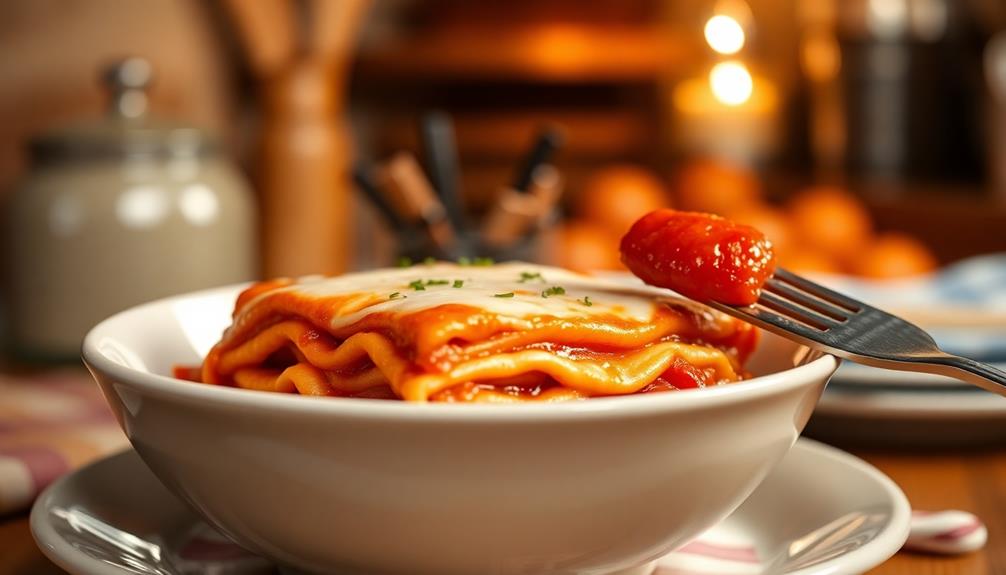
How does reheating transform leftovers into something even more delicious? When you reheat, you give the flavors in your food a chance to meld and intensify. This process often results in a more balanced taste profile compared to when the dish was fresh.
For example, the Maillard reaction and caramelization can continue during reheating, adding complexity and depth to meats and casseroles. Dishes like Chilaquiles benefit from this, as the salsa and cheese flavors deepen overnight, creating a delicious fusion of tastes.
To get the best results, consider using lower microwave power settings, around 50%. This helps promote even heating and prevents moisture loss, keeping the texture intact. You might also try reheating methods like using broth or steaming, which maintain moisture levels and guarantee that the flavors remain rich and satisfying.
Proper reheating techniques can even break down proteins further, enhancing the umami perception in your leftovers. As you savor each bite, you may find that the second day's flavors pack a punch that fresh dishes sometimes lack.
Psychological Aspects of Taste
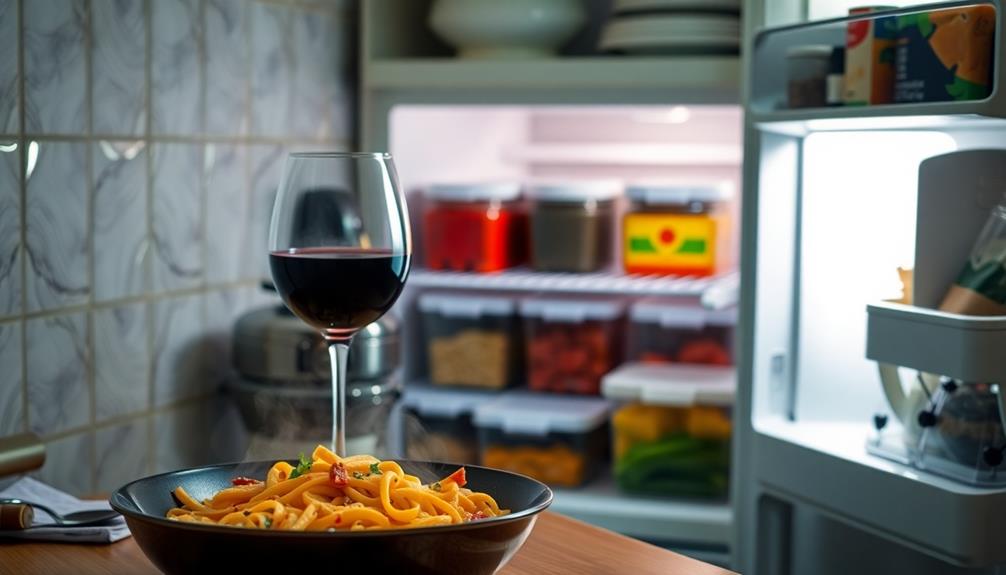
When you sit down to enjoy leftovers, the experience often goes beyond just the food on your plate. It's about the emotional connections tied to that meal. Positive memories from past dining experiences can enhance your taste perception, making those leftovers even more enjoyable.
For example, savoring a dish like Horiatiko Psomi (Country Bread) evokes feelings of warmth and hospitality, which can make the flavors feel even richer. The anticipation of savoring a familiar dish can create a positive mindset, leading you to appreciate the flavors more deeply.
Context matters too. Sharing leftovers with family or friends can shape your food preferences and elevate the taste experience. When you recall the laughter and conversations that accompanied a meal, it adds a layer of satisfaction that can transform your leftovers into something special.
Cravings for comfort foods often arise from these emotional ties, reinforcing the idea that leftovers are more than just food; they're a connection to past moments.
As you eat, your brain responds to these associations, making the flavors feel richer and more appealing. So, the next time you dig into those leftovers, remember that it's not just about taste—it's about the memories and feelings that come with each bite, enhancing your overall experience.
Best Practices for Leftovers

To enjoy your leftovers safely and deliciously, start by storing them in airtight containers to keep out air and moisture.
Foods like Loaded Baked Potatoes often taste even better the next day as the flavors meld together.
Always cool your food quickly before refrigerating, and aim to consume it within three to four days.
When reheating, make sure to only heat what you plan to eat, bringing it to at least 165°F to eliminate any bacteria.
Proper Storage Techniques
Proper storage techniques are vital for keeping your leftovers fresh and tasty. Start by transferring your food into airtight containers. This minimizes exposure to air and moisture, which can degrade flavor and texture.
It's important to cool your food quickly before refrigerating—ideally within two hours of cooking—to prevent bacterial growth and maintain freshness.
Label your containers with dates so you can easily track how long the leftovers have been in your fridge. Consuming them within the recommended timeframe of three to four days guarantees maximum safety and taste.
Remember, leftovers shouldn't be left at room temperature for more than two hours; this includes the danger zone for bacterial growth, which is between 40-140°F.
For soups and stews, use shallow containers. This allows for quicker temperature reduction, enhancing food safety while keeping the flavors intact.
Safe Reheating Methods
After storing your leftovers correctly, the next step is reheating them safely to enjoy their flavors at their best. To guarantee safe consumption, only reheat the portion you plan to eat. This practice minimizes temperature fluctuations that can encourage bacterial growth.
Always heat your leftovers to an internal temperature of at least 165°F or until they're steaming hot throughout.
When using a microwave, opt for lower power settings (around 50%) to achieve even reheating. This method helps prevent hot spots that can compromise the texture and flavor of your food.
For maximum safety and quality, consider reheating in an oven or on the stovetop. These methods retain moisture better, enhancing the overall texture of your leftovers.
Don't forget to store your leftovers in airtight containers and label them with dates. The USDA recommends consuming them within 3 to 4 days to guarantee maximum safety.
Cultural Attitudes Towards Leftovers
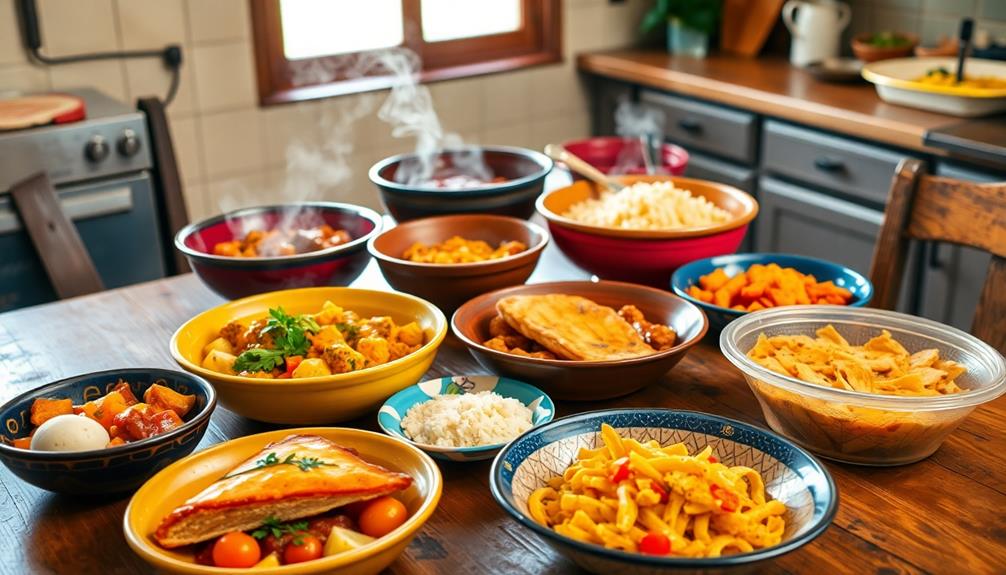
Embracing leftovers can reveal a lot about cultural attitudes towards food. In many cultures, leftovers are celebrated and transformed into new dishes, showcasing resourcefulness and creativity. Think of Italian frittatas or Asian fried rice; these meals highlight how different societies value the flavors that develop over time. This appreciation contrasts sharply with cultures that view leftovers as inferior to freshly made meals.
Your perspective on leftovers may also reflect broader social attitudes. In some communities, consuming leftovers is seen as a practical way to minimize food waste and promote sustainability. Practices like "taco night" in American households illustrate how people creatively repurpose leftover ingredients, turning them into enjoyable meals.
However, the stigma surrounding leftovers can be influenced by socioeconomic factors. In certain circles, freshly prepared foods symbolize wealth and superior taste, making leftovers seem less desirable.
Understanding these cultural attitudes helps you appreciate the diverse ways people approach food, waste, and sustainability. So next time you find yourself with leftovers, consider their cultural significance and the resourcefulness they represent in different culinary traditions.
Common Misconceptions About Leftovers
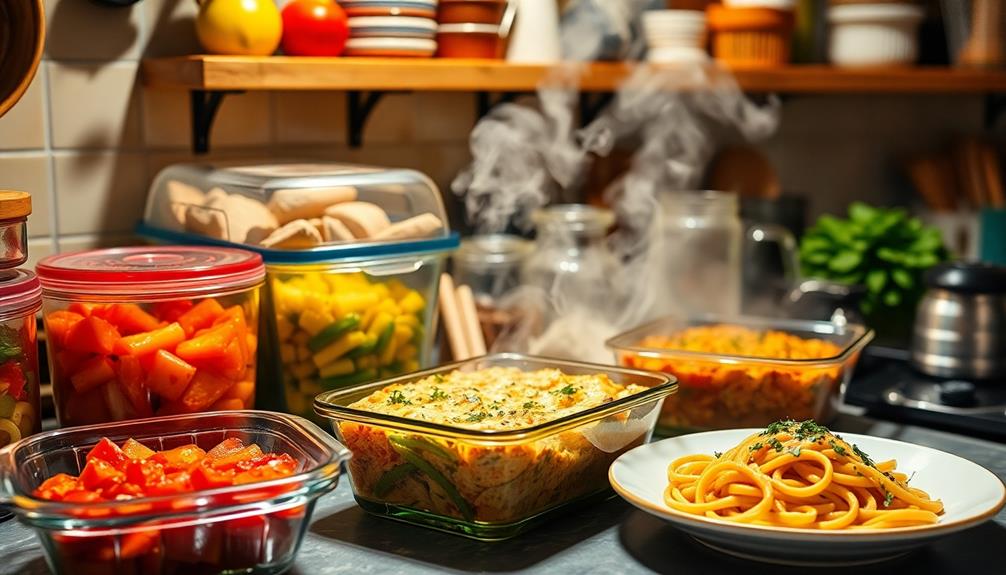
Cultural attitudes towards leftovers can shape how we perceive them, leading to various misconceptions. Many believe that all leftovers taste worse than freshly cooked meals, but that's far from the truth. In fact, certain dishes, like soups and stews, often taste better as the flavors meld over time.
Here are some common misconceptions you might encounter:
- Reheating kills nutrients: Many foods retain their nutritional value and can even enhance flavors.
- Leftovers must be eaten immediately: Meals like curries and lasagnas develop richer flavors after a day or two in the fridge.
- Reheated foods lack moisture: With proper techniques, you can maintain or boost the mouthfeel of casseroles and braised meats.
- Leftovers look unappetizing: The evolution of flavors can make these meals even more enjoyable, especially in a communal setting.
- All leftovers taste the same: Foods taste different after sitting, often improving in complexity and richness.
Texture Changes in Leftover Foods
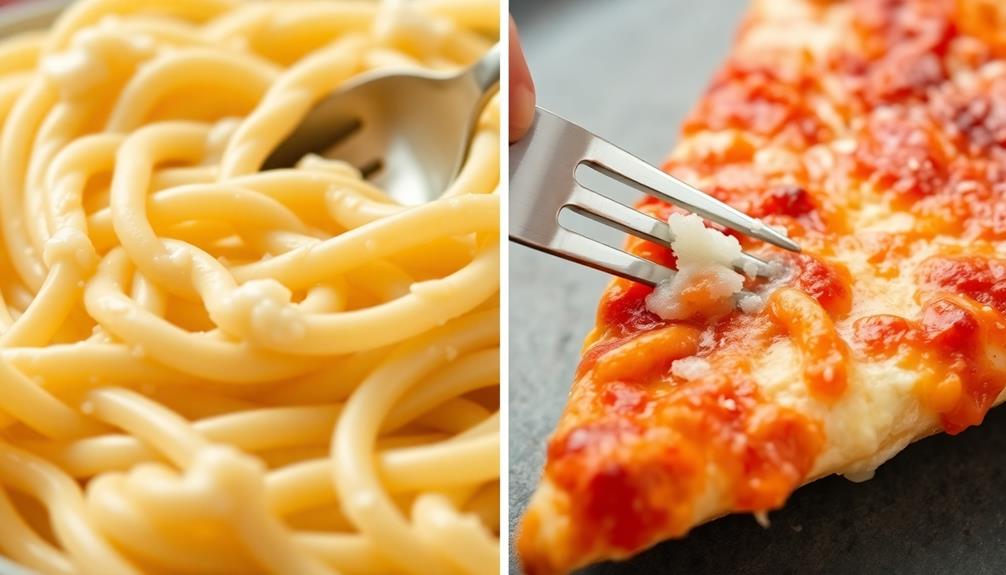
Leftover foods often undergo fascinating texture transformations that can elevate your dining experience. When you reheat stews and sauces, they often become thicker and creamier. This happens because gelatin released from meat and starches helps trap flavor, enhancing your dish's richness.
However, some texture changes can be less desirable. For instance, when gelatinized starches cool, they undergo retrogradation, affecting dishes like mashed potatoes. This process alters the texture as the starches absorb moisture and revert to a crystalline structure.
On the other hand, ground meat tends to retain more flavor in leftovers due to its increased surface area, which helps it maintain moisture and taste. Pre-cooked noodles in dishes like lasagna can yield a mushier texture and less distinct flavors compared to uncooked noodles, impacting your overall enjoyment.
As you reheat leftover meats and rich sauces, the breakdown of gelatin provides a silky mouthfeel, making the dish feel more luxurious. These texture changes can truly transform your leftovers, offering a delightful experience that might even surpass the original meal.
Food Safety Guidelines for Leftovers

To enjoy your leftovers safely, it's crucial to follow some essential food safety guidelines. By taking a few simple steps, you can guarantee that your meals remain delicious and safe to eat.
Here are some key points to keep in mind:
- Consume leftovers within three to four days for peak safety and quality.
- Discard foods left at room temperature for over two hours to prevent bacterial growth.
- Use proper cooling techniques, like chilling food quickly and storing it in shallow containers.
- Reheat leftovers to an internal temperature of 165°F to kill any potential bacteria.
- Store leftovers in airtight containers to minimize exposure to air and extend freshness.
Frequently Asked Questions
Why Does Leftover Meat Taste Different?
Leftover meat tastes different because proteins break down into free amino acids, enhancing umami flavors. The Maillard reaction continues to develop, while reheating releases trapped flavor molecules, creating a richer taste than when freshly cooked.
Why Did Food Taste Better in the Past?
In the past, culinary craftsmanship created vibrant, varied flavors. Fresh, seasonal ingredients and traditional techniques brought depth to dishes. You'd savor the richness of meals, each bite steeped in history, nostalgia, and love.
What Foods Taste Good as Leftovers?
You'll find soups, stews, and casseroles taste incredible as leftovers. Dishes like lasagne and spicy curries develop richer flavors, while pasta sauces thicken, creating satisfying meals perfect for reheating and enjoying the next day.
Why Do I Prefer Leftovers?
You prefer leftovers because they offer convenience and familiarity. You enjoy the comforting memories tied to them, and often, their flavors deepen and improve, making each bite feel richer and more satisfying than the first.
Conclusion
Leftovers are like a fine wine—often, they get better with age. As flavors meld and deepen, each bite becomes a nostalgic journey, reminding you of the meal's initial warmth. Embracing these culinary treasures not only satisfies your taste buds but also reflects a richer, more mindful approach to food. So, next time you dig into yesterday's dinner, remember: great things often come to those who wait, transforming ordinary moments into extraordinary experiences. Enjoy the journey! Even like the smooth transition of beer from producer to consumer, leftovers carry the essence of their creation, bringing with them the care and thoughtfulness of the original meal. With each reheated bite, you don’t just eat—you relive the experience, appreciating the evolution of flavors and textures. So, raise your fork, and savor the small joys found in each leftover masterpiece.
